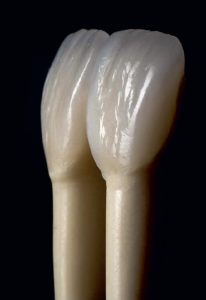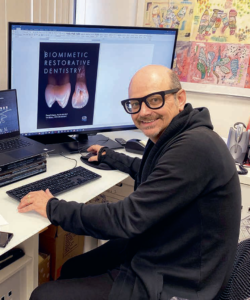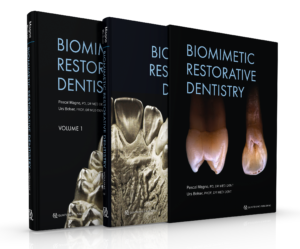
Anyone who has ever met Dr Pascal Magne knows he’s a passionate guy. He’s passionate about dentistry. He’s passionate about art. Above all he’s passionate about sharing his faith. And it is this passion that has pushed him to always strive for excellence. It is also this passion that pushed him many years ago to write Bonded Porcelain Restorations in the Anterior Dentition: A Biomimetic Approach with Dr Urs Belser, one of the best-selling Quintessence books of all time. Nearly 20 years later, he and Dr Belser have put the finishing touches on the highly anticipated second edition, renamed Biomimetic Restorative Dentistry, which is due out in November 2021.
Biomimetic restorative dentistry is all about restoring or mimicking the biomechanical, structural, and esthetic integrity of teeth. Biomimetics in restorative dentistry starts with an understanding of hard tissue structure and related stress distribution within the intact tooth. This scientific knowledge coupled with a good clinical understanding of ultraconservative preparation methods and adhesive concepts enable good biomimicry. After all, the adhesive revolution has completely changed the way we approach restorative dentistry. Dr Magne explains it like this: “When I graduated, we were sacrificing so much tooth substrate in the name of retention and resistance form, but the biomimetic approach has provided principles for using adhesive procedures in a synergistic way, combining composite resins and ceramics. We are using materials that are not necessarily the strongest but the most synergistic with the tooth.” In so doing, he can save teeth and precious tooth structure while promoting natural esthetics.

As such, the principles underlying natural oral esthetics are crucial to understand, because of course you can only mimic something well if you understand its characteristics in the first place and can visualize the artistry inherent to natural form. Dr Magne knows this too well: “Restorative dentistry is not a creative art (we are not creating something new), but it requires the ability to copy natural teeth (hyperrealism). It also requires the ability to balance a composition (the smile), as explained in the new edition of the book, which also includes drawing exercises to help the brain to develop the five essential perceptual skills of frame, contours, elements, light and shadow, and gestalt.”

Biomimetics is therefore an exercise in conservative dentistry AND esthetic composition. As Dr Magne puts it, “biomimetic restorations have extrinsic beauty (visible) and intrinsic mimetism (function and mechanics).” BOTH are essential for restorative success.
 Yet biomimetics is still met with some skepticism because of a lack of belief in adhesion, despite scores of evidence to the contrary. Dentists across the world are unnecessarily sacrificing tooth structure, and as Dr Magne points out, “the same clinicians are seduced by manufacturers with products that may be easier and faster to use but not better.” That’s why Dr Magne and Dr Belser have updated their book to include all the research and techniques developed in the last two decades. Much has changed, with the development of digitally guided implant dentistry, guided tissue regeneration, and CAD/CAM restorations, yet the principles of biomimetics have not. These are just new tools, not new concepts.
Yet biomimetics is still met with some skepticism because of a lack of belief in adhesion, despite scores of evidence to the contrary. Dentists across the world are unnecessarily sacrificing tooth structure, and as Dr Magne points out, “the same clinicians are seduced by manufacturers with products that may be easier and faster to use but not better.” That’s why Dr Magne and Dr Belser have updated their book to include all the research and techniques developed in the last two decades. Much has changed, with the development of digitally guided implant dentistry, guided tissue regeneration, and CAD/CAM restorations, yet the principles of biomimetics have not. These are just new tools, not new concepts.
As Dr Magne writes, “the second edition consolidates the first one, a little bit like the Old and New Testaments of the Bible (LOL). Advances have been impacting the entire spectrum of restoration types, starting with direct restorations with more predictable materials, especially the esthetic outcome using bilaminar shade guides, the natural layering technique, as well as many new tools and restorative strategies such as deep margin elevation. Semi-(in)direct restorations have expanded thanks to the development of CAD/CAM technology and materials, and indirect restorations have also been facilitated by 3D printing of the working models. But passionate handcrafting of the restoration is what makes the ultimate difference—the passion and love of the operator for attaining the biomimetic result biologically, mechanically, functionally, and esthetically.”

The same principles introduced 20 years ago still apply. In the end, prudence and wisdom need to be combined with knowledge and progress when it comes to improving our patients’ welfare. But passion and love for the craft is the starting point—always.
 Dr Pascal Magne is an Associate Professor with tenure and the Don and Sybil Harrington Foundation Professor of Esthetic Dentistry in the Division of Restorative Sciences at the University of Southern California Herman Ostrow School of Dentistry in Los Angeles. He graduated from the University of Geneva Dental School in Switzerland in 1989 with a Med Dent degree and later obtained his doctorate in 1992 and his Privat Docent degree in 2002. Dr Magne received postgraduate training in fixed prosthodontics and occlusion, operative dentistry, and endodontics and was a lecturer at the same university beginning in 1989 until 1997. From 1997 to 1999, he was a Visiting Associate Professor at the Minnesota Dental Research Center for Biomaterials and Biomechanics at the University of Minnesota School of Dentistry. After concluding 2 years of research, Dr Magne returned to the University of Geneva Dental School before being recruited to the University of Southern California in February 2004. He is the recipient of multiple awards and the author of numerous clinical and research articles on esthetics and adhesive dentistry, as well as an internationally known mentor and lecturer on these topics. The first edition of this textbook has been translated into 12 languages and is considered one of the most outstanding books in the field of adhesive and esthetic dentistry. Dr Magne is a founding member of the Academy of Biomimetic Dentistry and a mentor of the Bio- Emulation think-tank group. In 2012, he launched a revolutionary approach to the teaching of dental morphology, function, and esthetics (the 2D/3D/4D approach) for freshman students at the Herman Ostrow School of Dentistry at USC.
Dr Pascal Magne is an Associate Professor with tenure and the Don and Sybil Harrington Foundation Professor of Esthetic Dentistry in the Division of Restorative Sciences at the University of Southern California Herman Ostrow School of Dentistry in Los Angeles. He graduated from the University of Geneva Dental School in Switzerland in 1989 with a Med Dent degree and later obtained his doctorate in 1992 and his Privat Docent degree in 2002. Dr Magne received postgraduate training in fixed prosthodontics and occlusion, operative dentistry, and endodontics and was a lecturer at the same university beginning in 1989 until 1997. From 1997 to 1999, he was a Visiting Associate Professor at the Minnesota Dental Research Center for Biomaterials and Biomechanics at the University of Minnesota School of Dentistry. After concluding 2 years of research, Dr Magne returned to the University of Geneva Dental School before being recruited to the University of Southern California in February 2004. He is the recipient of multiple awards and the author of numerous clinical and research articles on esthetics and adhesive dentistry, as well as an internationally known mentor and lecturer on these topics. The first edition of this textbook has been translated into 12 languages and is considered one of the most outstanding books in the field of adhesive and esthetic dentistry. Dr Magne is a founding member of the Academy of Biomimetic Dentistry and a mentor of the Bio- Emulation think-tank group. In 2012, he launched a revolutionary approach to the teaching of dental morphology, function, and esthetics (the 2D/3D/4D approach) for freshman students at the Herman Ostrow School of Dentistry at USC.
 Biomimetic Restorative Dentistry, Second Edition
Biomimetic Restorative Dentistry, Second Edition
Pascal Magne and Urs Belser
The first edition of this book took the dental world by storm in 2002 and became one of the best-selling Quintessence books of all time, and this edition will no doubt do the same. It takes the science of esthetic dental reconstruction to a new level both clinically and academically, and it offers all that a clinician could wish for in terms of indications and the classic clinical steps for tooth preparation, laboratory and CAD/CAM procedures, adhesive luting procedures, and maintenance. But above all, what makes this book so unique is the underlying principle that Pascal Magne lives by: respect the natural structure and use that nature as your guide in restoration. The central philosophy of the book is the biomimetic principle—that is, the idea that the intact tooth in its ideal hues and shades, and perhaps more importantly in its intracoronal anatomy and location in the arch, is the guide to reconstruction and the determinant for success. Restoring or mimicking the biomechanical, structural, and esthetic integrity of teeth is paramount. Therefore, the objective of this book is to propose new criteria for esthetic restorative dentistry based on biomimetics. The driving forces of restorative dentistry are maintenance of tooth vitality and maximum conservation of intact hard tissues, and as such the book offers ultraconservative treatment options that can precede a more sophisticated treatment. The core of the book centers of the application of the biomimetic principle in the form of bonded restorations using composite resins and ceramics. The broad spectrum of indications of bonded restorations is described, followed by detailed instruction on the treatment planning and diagnostic approach, which is the first step for every case. The treatment is then described step by step, including tooth preparation and impression, laboratory and CAD/CAM procedures related to the fabrication of composite resin and ceramic workpieces, and their final insertion through adhesive luting procedures. Volume 1 covers the fundamentals and basic procedures, and Volume 2 focuses on advanced clinical techniques, maintenance, and repair of bonded restorations. QR codes throughout link to demonstrations of the techniques and dramatic videos highlighting the artistry of biomimetics. Written by a true master and true artist, this book will undoubtedly inspire excellence in anyone who picks it up.
888 pp in 2 volumes; 2,500 illus; © 2021; ISBN 978-0-86715-572-3 (B5723); US $322 (preorder)
